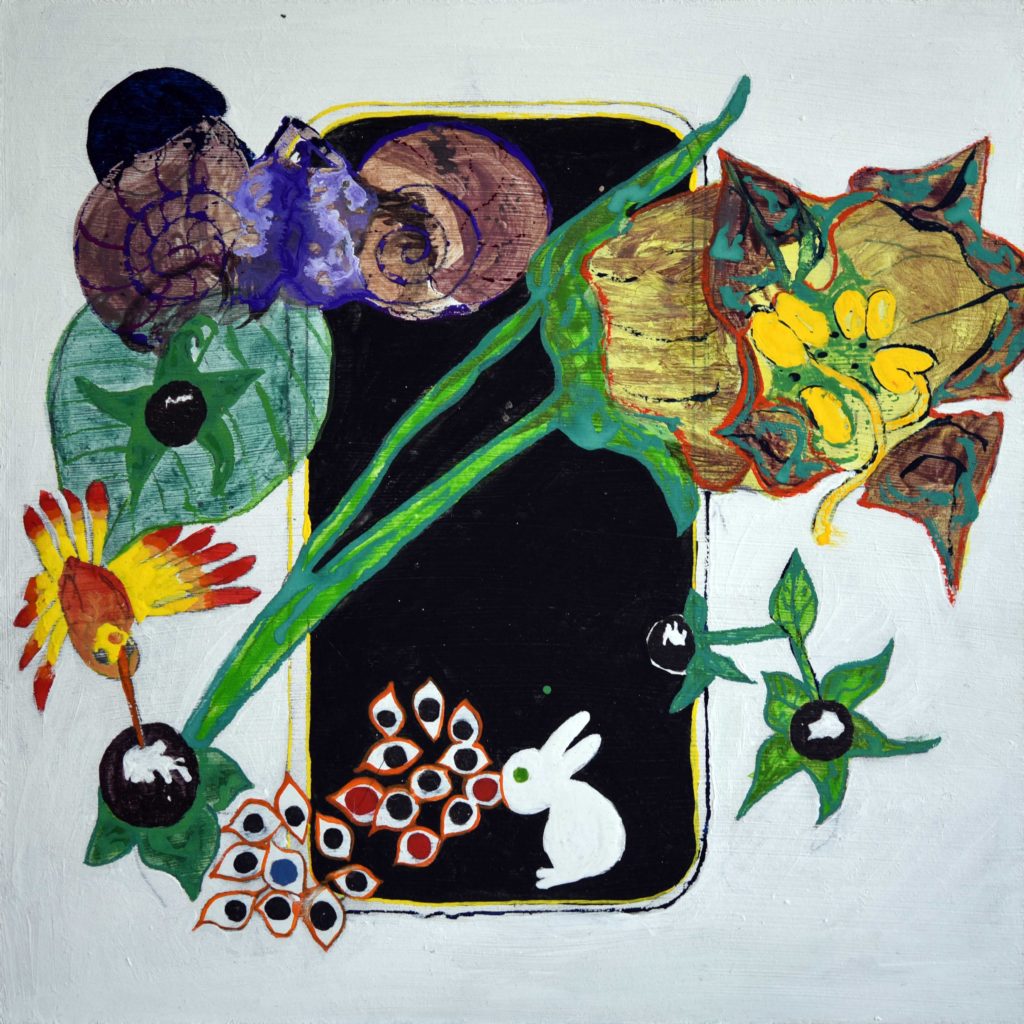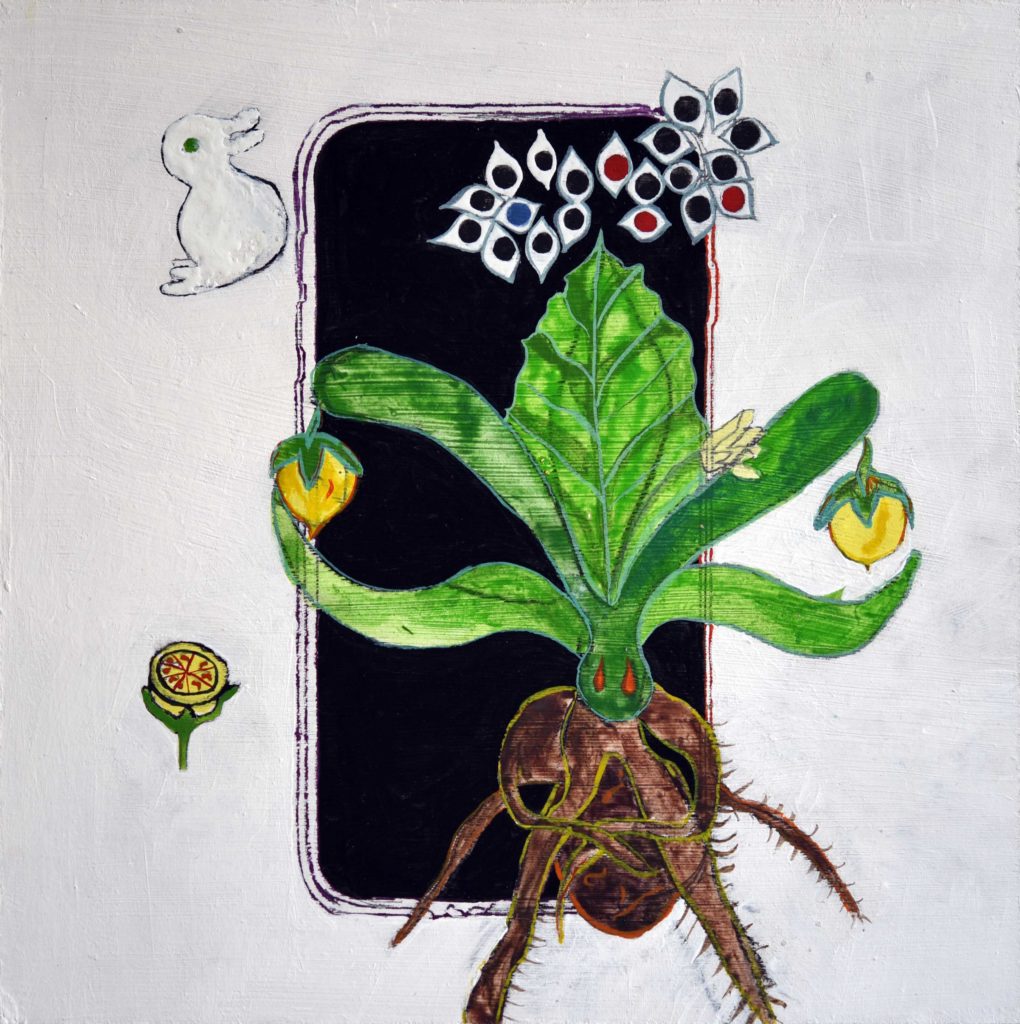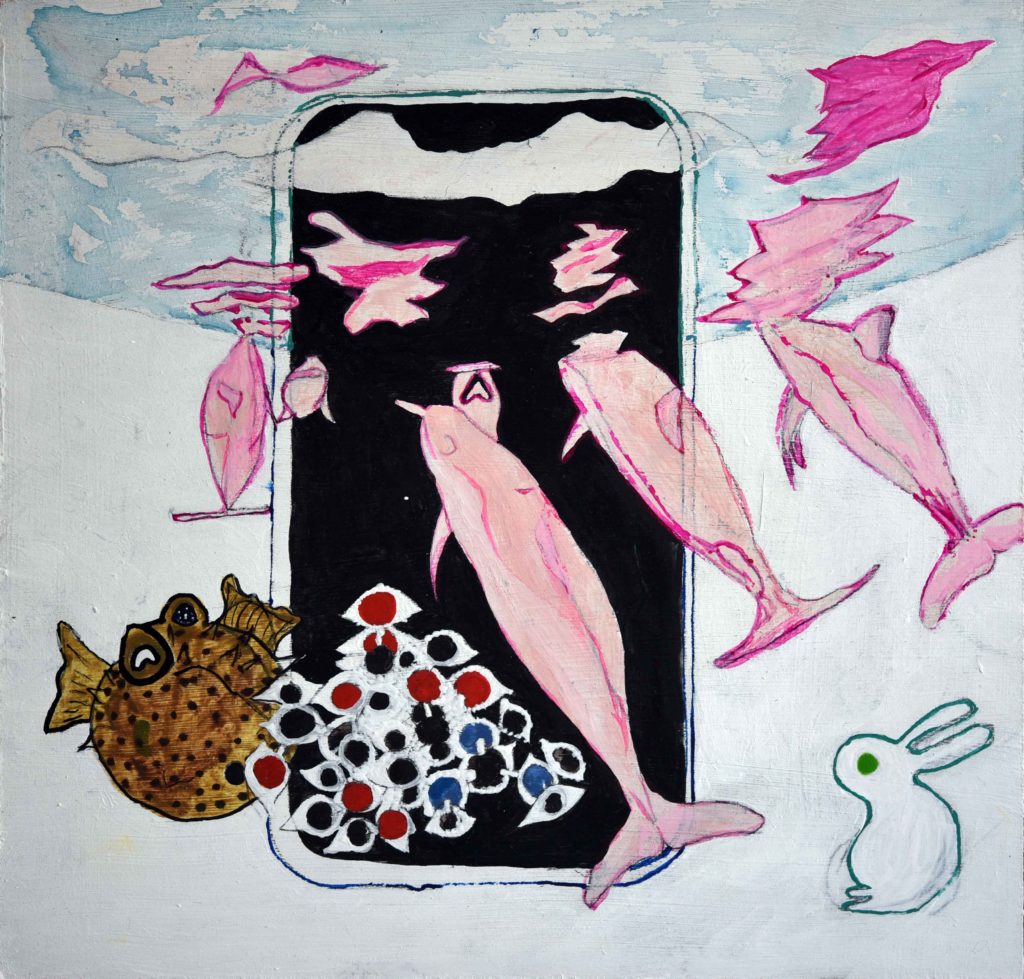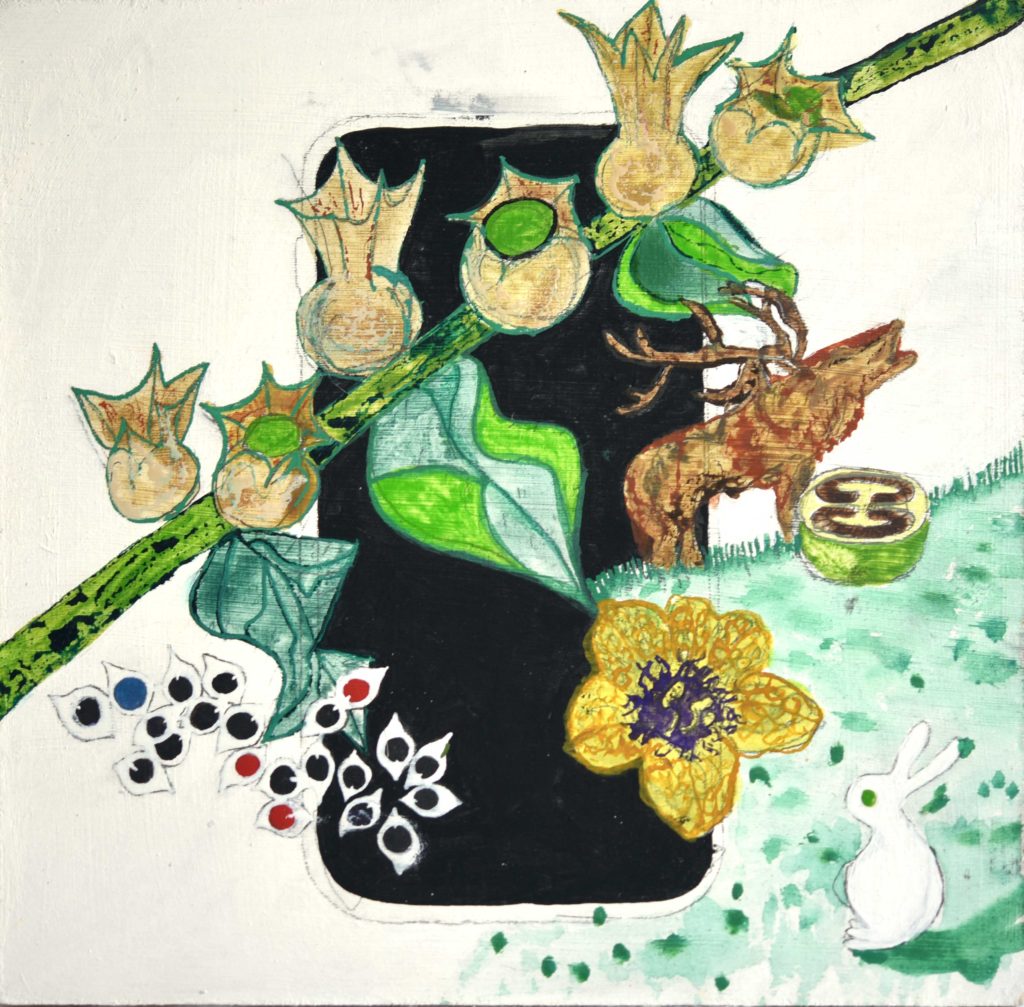





Lapin Canard
Avec Lapin Canard, Fiona Valentine Thomann développe une œuvre exigeante et subtile, interrogeant la tension entre le visible et l’invisible, le tangible et l’immatériel. À travers une série de petites peintures centrées sur des plantes psychoactives, l’artiste déploie un univers à la fois poétique et hautement conceptuel. Chaque composition s’articule autour d’un écran de smartphone noir et éteint, posé comme un “hors-cadre“ symbolique : il introduit un moment de silence au sein du flux permanent d’images et d’informations, invitant à ralentir le regard et à questionner ce que nous choisissons de voir, ou d’ignorer.
Ces plantes, choisies avec soin, belladone, jusquiame, mandragore, évoquent des savoirs ancestraux souvent marginalisés, associés aux sorcières et aux guérisseuses, tout en portant des propriétés psychotropes puissantes. Thomann intègre aussi la représentation d’une sculpture maya d’un niños santos, champignon hallucinogène nommé “petit saint“ par Maria Sabina, grande guérisseuse mazatèque. Ces références croisées font surgir la mémoire de traditions spirituelles occultées par l’histoire coloniale et médicale occidentale.
Chaque peinture révèle, de façon délicate et précise, les racines, feuilles ou fleurs de ces végétaux, tout en inscrivant symboliquement l’atome ou la formule chimique de leurs principes actifs. Cette alliance entre la dimension moléculaire et la dimension sensible fait directement écho à la pensée de Jeremy Narby, qui invite à faire dialoguer animisme et science.
Fiona Valentine Thomann enrichit encore la série par une peinture consacrée aux dauphins roses d’Amazonie, aujourd’hui menacés, mis en scène autour d’un smartphone noir. Ces dauphins, fascinants, interagissent parfois avec un poisson-globe toxique qu’ils se transmettent pour atteindre un état de conscience modifié : l’artiste y voit une pratique animale de l’altération des sens, à la lisière entre toxicité et expérience extatique.
Le motif du Lapin Canard, signature récurrente de Fiona Valentine Thomann, s’inspire de la figure perceptive décrite par Wittgenstein : voit-on un lapin ou un canard ? Par cette ambiguïté, l’artiste souligne la multiplicité des interprétations et la coexistence de mondes de pensée contradictoires. Cette démarche rejoint également la réflexion de Philippe Descola sur la confrontation entre naturalisme et animisme : et si l’Occident avait perdu, dans sa logique classificatoire, la capacité de dialoguer avec les subjectivités non humaines ?
Référence assumée à Les plantes des dieux et à Albert Hofmann, cette série ouvre une question radicale : et si certaines plantes européennes, aujourd’hui reléguées au statut de poisons, détenaient en réalité des savoirs thérapeutiques essentiels pour soigner nos troubles psychiques ?
En posant un écran noir comme point aveugle au milieu de la composition, Thomann crée un espace méditatif où ressurgissent des récits oubliés, libérés des cadres normatifs imposés par la technologie et la rationalité. Avec Lapin Canard, Fiona Valentine Thomann offre une œuvre critique et sensible, qui nous encourage à réapprendre à regarder, et à écouter, un vivant porteur de mémoires, de connaissances et de spiritualités invisibles.
Lapin Canard
With Lapin Canard, Fiona Valentine Thomann develops a demanding and subtle body of work that interrogates the tension between the visible and the invisible, the tangible and the immaterial. Through a series of small paintings focused on psychoactive plants, the artist constructs a universe that is both poetic and deeply conceptual. Each composition is structured around a black, switched-off smartphone screen, positioned as a symbolic “off-frame”: it introduces a moment of silence within the endless flow of images and information, inviting the viewer to slow down their gaze and question what they choose to see, or to ignore.
These carefully chosen plants, belladonna, henbane, mandrake, evoke ancestral knowledge that has often been marginalized, associated with witches and healers, while also carrying powerful psychotropic properties. Thomann also includes a depiction of a Mayan niños santos sculpture, referring to the hallucinogenic mushrooms called “little saints” by Maria Sabina, the great Mazatec healer. These cross-cultural references awaken the memory of spiritual traditions erased by colonial and medical history.
Each painting delicately and precisely reveals the roots, leaves, or flowers of these plants, while symbolically inscribing the atom or chemical formula of their active principles. This fusion of molecular science and sensory experience directly echoes the thinking of Jeremy Narby, who invites us to connect animism with scientific knowledge.
Fiona Valentine Thomann further enriches the series with a painting dedicated to the Amazonian pink river dolphins, today threatened with extinction, depicted surrounding a black smartphone screen. These dolphins, fascinating in their intelligence, sometimes interact with a pufferfish containing a powerful toxin, passing it among themselves to reach an altered state of consciousness: the artist reads in this behavior a kind of animal experimentation with sensory alteration, on the boundary between toxicity and ecstatic experience.
The Lapin Canard motif, a recurring signature of Fiona Valentine Thomann, is inspired by the perceptual figure described by Wittgenstein: do you see a rabbit or a duck? Through this ambiguity, the artist underscores the multiplicity of interpretations and the coexistence of contradictory worldviews. This line of questioning resonates with Philippe Descola’s reflection on the confrontation between naturalism and animism: what if the West, in its classificatory logic, had lost the ability to engage with non-human subjectivities?
Referencing The Plants of the Gods and Albert Hofmann, this series opens a radical question: what if some European plants, today dismissed as poisons, actually preserved ancestral knowledge essential for healing our mental and spiritual wounds?
By placing a black screen as a blind spot at the center of the composition, Thomann creates a meditative space where forgotten narratives can resurface, freed from the normative frames imposed by technology and rationality. With Lapin Canard, Fiona Valentine Thomann offers a critical and sensitive work that encourages us to relearn how to see, and to listen, to a living world rich in memories, knowledge, and invisible spiritualities.